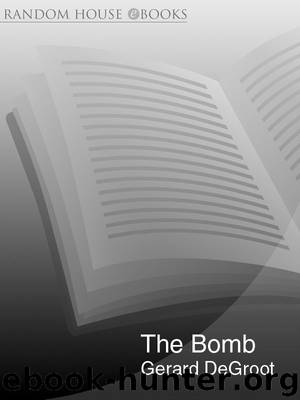The Bomb: A Life by Gerard DeGroot

Author:Gerard DeGroot [DeGroot, Gerard]
Language: eng
Format: epub
ISBN: 9781446449615
Publisher: Random House
Published: 2011-09-30T00:00:00+00:00
* * *
While the Americans were poisoning the Marshall Islanders, the Soviets were busy poisoning their own people. Russia’s weapons development complex eventually dwarfed its American counterpart. The main laboratories and factories were located in ten ‘nuclear cities’ – fortresses designed to exclude those from outside and to restrict the movement of those who lived and worked within. Arzamas-16 and Chelyabinsk-70 contained the weapons design laboratories, with the former also housing a warhead production plant. Penza-19, Sverdlovsk-45 and Zlatoust-36 contained the main warhead production plants. Krasnoyarsk-26, Krasnoyarsk-45, Tomsk-7, Chelyabinsk-65 and Sverdlovsk-44 produced fissile materials.
Chelyabinsk has been dubbed ‘the most contaminated spot on the planet’. From 1949 to 1956, around 76 million cubic metres of radioactive waste was dumped into the Techa River, resulting in an epidemic of various illnesses downstream from the site where around 124,000 people lived. Eventually, twenty-two villages along the riverbank had to be evacuated, but, for some reason, Muslyumovo, in which contamination was especially high, was never abandoned. Since the village had no well, the 4,000 residents depended entirely on river water for their needs.
Alarm bells were raised when radioactivity carried by the Techa was found in the Arctic ocean in 1951, but it was not until 1956 that measures to clean up the river were implemented. The dumping problem was ‘solved’ by diverting radioactive waste into self-contained lakes – Lake Karachay for high-level waste and Lake Staroe Boloto for medium-level waste. During hot summers, however, the lakes dried up whereupon winds blew radioactive dust over the surrounding countryside. In 1967, the dust blew over an area totalling 2,200 square kilometres.
An explosion in a nuclear waste storage tank on 29 September 1957, equivalent to 70 tons of TNT, resulted in a radioactive cloud over the provinces of Chelyabinsk, Sverdlovsk and Tyumen. Around 80 metric tonnes of waste was ejected, discharging 20 million curies of radioactivity. Plutonium and strontium were released across 60,000 square kilometres, an area now called the East Ural Radioactive Trace (EURT). The intensity of the radioactive release was double that which would be released in the 1986 accident at Chernobyl. Some 10,700 people were evacuated, but the incident was otherwise kept secret from the outside world. ‘When they evacuated us’, one woman recalled, ‘they made us sign a form saying that we wouldn’t reveal state secrets. Of course, we knew what that meant.’ Since 1957 there has been a 21 per cent increase in the incidence of cancer in the area, a 25 per cent increase in birth defects and 50 per cent of the population of child-bearing age are sterile.49
Download
This site does not store any files on its server. We only index and link to content provided by other sites. Please contact the content providers to delete copyright contents if any and email us, we'll remove relevant links or contents immediately.
| Africa | Americas |
| Arctic & Antarctica | Asia |
| Australia & Oceania | Europe |
| Middle East | Russia |
| United States | World |
| Ancient Civilizations | Military |
| Historical Study & Educational Resources |
The Radium Girls by Kate Moore(11608)
100 Deadly Skills by Clint Emerson(4683)
The Templars by Dan Jones(4556)
Rise and Kill First by Ronen Bergman(4542)
The Doomsday Machine by Daniel Ellsberg(4240)
The Rape of Nanking by Iris Chang(4018)
Killing England by Bill O'Reilly(3896)
Hitler in Los Angeles by Steven J. Ross(3796)
Stalin by Stephen Kotkin(3719)
12 Strong by Doug Stanton(3412)
Hitler's Monsters by Eric Kurlander(3156)
Blood and Sand by Alex Von Tunzelmann(3055)
Darkest Hour by Anthony McCarten(3017)
The Code Book by Simon Singh(2853)
The Art of War Visualized by Jessica Hagy(2833)
Hitler's Flying Saucers: A Guide to German Flying Discs of the Second World War by Stevens Henry(2620)
Babylon's Ark by Lawrence Anthony(2427)
The Second World Wars by Victor Davis Hanson(2419)
Tobruk by Peter Fitzsimons(2373)
